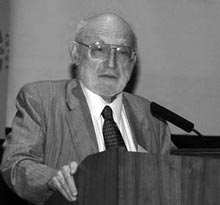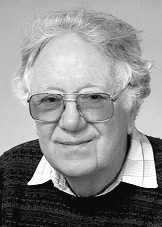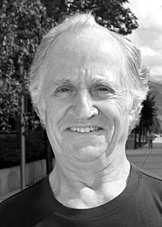
Giải Nobel sinh lý học và y học năm 2007 |
|
Vietsciences- Cao Xuân Hiếu - Huỳnh Như Ngọc Hiển 21/10/2007 |

Joshua Lederberg đoạt giải Nobel Y học năm 1958



Mario R. Capecchi, Martin J. Evans và Oliver Smithies
for their discoveries of "principles for introducing specific gene modifications in mice by the use of embryonic stem cells")
Modification of genes by homologous recombinationInformation about the development and function of our bodies throughout life is carried within the DNA. Our DNA is packaged in chromosomes, which occur in pairs – one inherited from the father and one from the mother. Exchange of DNA sequences within such chromosome pairs increases genetic variation in the population and occurs by a process called homologous recombination. This process is conserved throughout evolution and was demonstrated in bacteria more than 50 years ago by the 1958 Nobel Laureate Joshua Lederberg. Mario Capecchi and Oliver Smithies both had the vision that homologous recombination could be used to specifically modify genes in mammalian cells and they worked consistently towards this goal. Capecchi demonstrated that homologous recombination could take place between introduced DNA and the chromosomes in mammalian cells. He showed that defective genes could be repaired by homologous recombination with the incoming DNA. Smithies initially tried to repair mutated genes in human cells. He thought that certain inherited blood diseases could be treated by correcting the disease-causing mutations in bone marrow stem cells. In these attempts Smithies discovered that endogenous genes could be targeted irrespective of their activity. This suggested that all genes may be accessible to modification by homologous recombination.
Embryonic stem cells – vehicles to the mouse germ lineThe cell types initially studied by Capecchi and Smithies could not be used to create gene-targeted animals. This required another type of cell, one which could give rise to germ cells. Only then could the DNA modifications be inherited. Martin Evans had worked with mouse embryonal carcinoma (EC) cells, which although they came from tumors could give rise to almost any cell type. He had the vision to use EC cells as vehicles to introduce genetic material into the mouse germ line. His attempts were initially unsuccessful because EC cells carried abnormal chromosomes and could not therefore contribute to germ cell formation. Looking for alternatives Evans discovered that chromosomally normal cell cultures could be established directly from early mouse embryos. These cells are now referred to as embryonic stem (ES) cells. The next step was to show that ES cells could contribute to the germ line (see Figure). Embryos from one mouse strain were injected with ES cells from another mouse strain. These mosaic embryos (i.e. composed of cells from both strains) were then carried to term by surrogate mothers. The mosaic offspring was subsequently mated, and the presence of ES cell-derived genes detected in the pups. These genes would now be inherited according to Mendel’s laws. Evans now began to modify the ES cells genetically and for this purpose chose retroviruses, which integrate their genes into the chromosomes. He demonstrated transfer of such retroviral DNA from ES cells, through mosaic mice, into the mouse germ line. Evans had used the ES cells to generate mice that carried new genetic material.
Two ideas come together – homologous recombination in ES cellsBy 1986 all the pieces were at hand to begin generating the first gene targeted ES cells. Capecchi and Smithies had demonstrated that genes could be targeted by homologous recombination in cultured cells, and Evans had contributed the necessary vehicle to the mouse germ line – the ES-cells. The next step was to combine the two. For their initial experiments both Smithies and Capecchi chose a gene (hprt) that was easily identified. This gene is involved in a rare inherited human disease (Lesch-Nyhan syndrome). Capecchi refined the strategies for targeting genes and developed a new method (positive-negative selection, see Figure) that could be generally applied. Birth of the knockout mouse – the beginning of a new era in geneticsThe first reports in which homologous recombination in ES cells was used to generate gene-targeted mice were published in 1989. Since then, the number of reported knockout mouse strains has risen exponentially. Gene targeting has developed into a highly versatile technology. It is now possible to introduce mutations that can be activated at specific time points, or in specific cells or organs, both during development and in the adult animal. Gene targeting is used to study health and diseaseAlmost every aspect of mammalian physiology can be studied by gene targeting. We have consequently witnessed an explosion of research activities applying the technology. Gene targeting has now been used by so many research groups and in so many contexts that it is impossible to make a brief summary of the results. Some of the later contributions of this year's Nobel Laureates are presented below. Gene targeting has helped us understand the roles of many hundreds of genes in mammalian fetal development. Capecchis research has uncovered the roles of genes involved in mammalian organ development and in the establishment of the body plan. His work has shed light on the causes of several human inborn malformations. Evans applied gene targeting to develop mouse models for human diseases. He developed several models for the inherited human disease cystic fibrosis and has used these models to study disease mechanisms and to test the effects of gene therapy. Smithies also used gene targeting to develop mouse models for inherited diseases such as cystic fibrosis and the blood disease thalassemia. He has also developed numerous mouse models for common human diseases such as hypertension and atherosclerosis. In summary, gene targeting in mice has pervaded all fields of biomedicine. Its impact on the understanding of gene function and its benefits to mankind will continue to increase over many years to come.
|
Biến đổi gene bằng tái tổ hợp tương đồngThông tin quy định quá trình hoạt động và phát triển của cơ thể trong suốt cuộc đời được mã hóa trong DNA. Các phân tử DNA được lưu trữ trong những cặp nhiễm sắc thể, mà trong mỗi cặp có một nhiễm sắc thể nhận từ cha và chiếc còn lại nhận từ mẹ. Những đoạn DNA trên cặp nhiễm sắc thể có thể đổi chỗ cho nhau trong quá trình tái tổ hợp tương đồng (homologous recombination). Đây chính là nhân tố làm tăng đa dạng di truyền trong quần thể và được bảo tồn xuyên suốt quá trình tiến hóa của sinh giới. Cơ chế tái tổ hợp tương đồng đã được phát hiện đầu tiên ở vi khuẩn hơn 50 năm về trước bởi Joshua Lederberg, người đoạt giải Nobel Y học năm 1958. Cả hai Mario Capecchi và Oliver Smithies đã có ý tưởng lợi dụng cơ chế tái tổ hợp tương đồng để sửa đổi một cách đặc hiệu các gene ở tế bào động vật có vú và họ đã thực hiện hàng loạt công trình để phát triển ý tưởng này. Capecchi đã chứng minh bằng thực nghiệm rằng tái tổ hợp tương đồng có thể xảy ra trong tế bào đông vật có vú giữa đoạn DNA ngoại lai và nhiễm sắc thể (chromosomes) của tế bào vật chủ. Ông đã cho thấy rằng các gene khiếm khuyết có thể được sửa lại thông qua sự tái tổ hợp tương đồng bằng cách đưa vào tế bào những đoạn DNA lành lặn. Smithies là người đầu tiên đã thử sửa sai các gene đột biến ở tế bào người. Ông nghĩ rằng một số bệnh di truyền về máu có thể chữa trị được bằng cách sửa chữa các đột biến gây bệnh tại những tế bào nguồn tủy xương. Trong quá trình nghiên cứu, Smithies đã khám phá ra rằng các gene nội sinh (endogenous) của cơ thể cũng có thể bị điều khiển hoạt động một cách bất thuận nghịch thông qua cơ chế này. Điều này cho thấy rằng tất cả các gene đều có thể bị biến đổi đặc hiệu thông qua kỹ thuật tái tổ hợp tương đồng. Tế bào nguồn tạo phôi ở chuột có thể trở thành tế bào nguồn dòng tinhCác loại tế bào ban đầu được Capecchi và Smithies nghiên cứu không thể tạo nên những cơ thể động vật biến đổi gene. Điều này đòi hỏi những nhà khoa học phải tìm ra một loại tế bào khác có thể phát triển thành tế bào sinh giao tử (germ cells, tế bào dòng tinh). Chỉ với loại tế bào này, các biến đổi gene mới có khả năng di truyền tạo nên những thế hệ cơ thể mang biến đổi gene. Martin Evans đã làm việc nhiều năm với các tế bào nguồn ung thư ở chuột (embryonal carcinoma, EC), đây là các tế bào được lấy từ những khối u và có thể biệt hóa thành nhiều loại tế bào. Ông đã có ý tưởng sử dụng tế bào EC để mang những biến đổi gene vào trong tế bào dòng tinh ở chuột. Cố gắng của ông ban đầu không thành công bởi vì các tế bào EC mang nhiễm sắc thể bất thường đã không thể sản sinh tinh trùng. Trong quá trình tìm kiếm giải pháp thay thế, Evans phát hiện ra rằng người ta có thể thiết lập các dòng tế bào nuôi cấy có nhiễm sắc thể bình thường từ chính những tế bào phôi chuột ở giai đoạn đầu. Những tế bào loại này hiện nay được gọi là tế bào nguồn tạo phôi (embryonic stem , ES). Các nghiên cứu sau đó theo hướng này đã cho thấy tế bào ES có thể tạo nên các tế bào dòng tinh (xem hình trên). Người ta đã tiêm tế bào ES của một chủng chuột vào phôi của một chủng chuột khác. Các phôi khảm này (mosaic embryos , chú thích, mang tế bào của cả hai chủng chuột) được cấy vào một con chuột mẹ mang thai. Những con chuột sinh ra là những thể khảm và sau đó được lai với nhau để kiểm tra sự hiện diện những gene đặc trưng của tế bào ES trên thế hệ chuột tiếp theo. Những gene này sau đó được di truyền theo các định luật Mendel. Sau đó Evans đã bắt đầu tìm cách thay đổi gene của các tế bào ES. Để thực hiện mục đích này ông đã chọn retrovirus, loại virus có thể sát nhập gene của chúng vào trong nhiễm sắc thể. Ông đã chứng mình bằng thực nghiệm sự vận chuyển DNA của retrovirus từ tế bào ES, thông qua chuột khảm, vào trong tế bào dòng tinh của thế hệ chuột sau đó. Như vậy, Evans đã sử dụng các tế bào ES để tạo ra những con chuột mang biến đổi di truyền. Hai ý tưởng lớn gặp nhau - tái tổ hợp tương đồng ở tế bào ESVào năm 1986 mọi tiền đề để tạo nên những tế bào ES mang gene bị biến đổi bằng cơ chế định hướng gene đã sẵn sàng. Capecchi và Smithies trước đó đã chứng minh các gene trong tế bào nuôi cấy có thể bị biến đổi thông qua tái tổ hợp tương đồng, và Evans đã tạo nên cách thức cần thiết để tạo ra tế bào tinh trùng chuột - đó là tế bào ES. Bước tiếp theo là kết hợp hai công trình này lại. Trong những thí nghiệm đầu tiên, cả Capecchi và Smithies chọn gene hprt, vì gene này dễ phát hiện. Đây là gene liên quan đến một bệnh di truyền hiếm gặp ở người (hội chứng Lesch-Nyhan). Capecchi đã cải tiến kỹ thuật định hướng gene và phát triển một phương pháp chọn lọc mới (chọn lọc có - không, xem hình) có tính khả dụng cao. Con chuột "knock-out" đầu tiên chào đời - sự bắt đầu của một kỉ nguyên mới trong di truyền họcNhững công trình đầu tiên sử dụng kỹ thuật tái tổ hợp tương đồng ở tế bào ES để tạo ra những con chuột biến đổi gene được công bố vào năm 1989. Kể từ đó những công trình tạo ra các chủng chuột bị bất hoạt gene đã gia tăng theo cấp số nhân. Định hướng gene đã phát triển thành một kĩ thuật có tính khả dụng cao. Giờ đây những nhà khoa học đã có thể tạo ra những cơ thể mang các đột biến được hoạt hóa tại thời điểm nhất định, hoặc chỉ hoạt động trong những tế bào/cơ quan nhất định trong quá trình phát triển. Định hướng gene được sử dụng để nghiên cứu sức khỏe và bệnh tậtNhững nhà khoa học có thể áp dụng kỹ thuật định hướng gene để nghiên cứu hầu như mọi quá trình sinh lý ở động vật có vú. Ngày nay chúng ta đã và đang chứng kiến một sự bùng nổ các hoạt động nghiên cứu ứng dụng kĩ thuật này. Định hướng gene hiện nay đã được quá nhiều nhóm nghiên cứu sử dụng và được mô tả trong nhiều công trình mà người ta khó có thể tóm tắt ngắn gọn được. Do đó, một vài công trình gần đây của những người đoạt giải Nobel năm nay được chọn lọc để liệt kê dưới đây. Định hướng gene giúp chúng ta thấu hiểu vai trò của hàng trăm gene trong quá trình phát triển bào thai động vật có vú. Nghiên cứu của Capecchi tiết lộ vai trò của những gene liên quan trong quá trình phát triển cơ quan và trong cơ chế thiết lập hình trạng cơ thể ở động vật có vú. Công trình của ông đã làm sáng tỏ nguyên nhân của hàng loạt bệnh tật/dị tật bẩm sinh ở người. Evans đã ứng dụng định hướng gene để xây dựng mô hình chuột cho các bệnh ở người. Ông đã phát triển hàng loạt mô hình cho bệnh u xơ nang di truyền ở người, sử dụng những mô hình này để nghiên cứu cơ chế gây bệnh và kiểm tra hiệu quả của những liệu pháp gene. Smithies cũng đã sử dụng định hướng gene để phát triển mô hình chuột cho những bệnh di truyền chẳng hạn như u xơ nang, chứng thiếu máu. Ông cũng đã phát triển một số lớn chuột mô hình cho những bệnh thông thường ở người chẳng hạn cao huyết áp và xơ vữa động mạch. Tóm lại, định hướng gene ở chuột đã tràn ngập mọi lĩnh vực của y sinh học. Ảnh hưởng của nó tới sự thấu hiểu chức năng gene và những lợi ích của nó đối với nhân loại sẽ tiếp tục gia tăng trong nhiều năm nữa. |

This year's Nobel Laureates have made a series of ground-breaking discoveries concerning embryonic stem cells and DNA recombination in mammals. Their discoveries led to the creation of an immensely powerful technology referred to as gene targeting in mice. It is now being applied to virtually all areas of biomedicine – from basic research to the development of new therapies.
Gene targeting is often used to inactivate single genes. Such gene "knockout" experiments have elucidated the roles of numerous genes in embryonic development, adult physiology, aging and disease. To date, more than ten thousand mouse genes (approximately half of the genes in the mammalian genome) have been knocked out. Ongoing international efforts will make "knockout mice" for all genes available within the near future.
With gene targeting it is now possible to produce almost any type of DNA modification in the mouse genome, allowing scientists to establish the roles of individual genes in health and disease. Gene targeting has already produced more than five hundred different mouse models of human disorders, including cardiovascular and neuro-degenerative diseases, diabetes and cancer.
Mario R. Capecchi, born 1937 in Italy, US citizen, PhD in Biophysics 1967, Harvard University, Cambridge, MA, USA. Howard Hughes Medical Institute Investigator and Distinguished Professor of Human Genetics and Biology at the University of Utah, Salt Lake City, UT, USA.
Sir Martin J. Evans, born 1941 in Great Britain, British citizen, PhD in Anatomy and Embryology 1969, University College, London, UK. Director of the School of Biosciences and Professor of Mammalian Genetics, Cardiff University, UK.
Oliver Smithies, born 1925 in Great Britain, US citizen, PhD in Biochemistry 1951, Oxford University, UK. Excellence Professor of Pathology and Laboratory Medicine, University of North Carolina at Chapel Hill, NC, USA.
|
© http://vietsciences.free.fr và http://vietsciences. org Cao Xuân Hiếu và Huỳnh Như Ngọc Hiển (Tủ sách Khoa học VLOS).
|